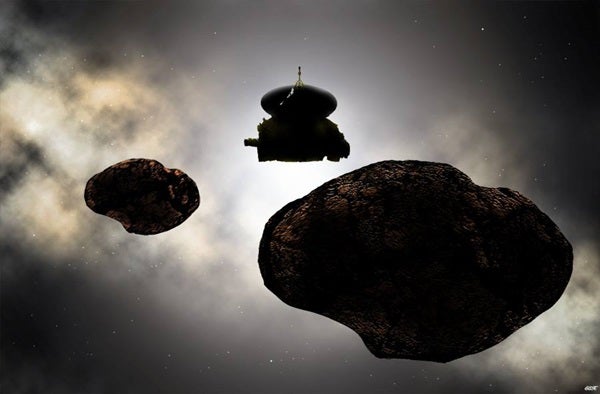NASA’s New Horizons spacecraft is awake — temporarily — for a short burst of activity while on its way to its post-Pluto target in the Kuiper Belt, an object known as 2014 MU69. The spacecraft was put into hibernation mode April 7 to save power on its long journey, which is not yet complete. Now that it’s awake, the mission team will begin performing instrument checks and data collection for the next three months, as well as an additional flight path correction, before the spacecraft is returned to hibernation until it’s ready to encounter MU69 in 2019.
There are several reasons to place a spacecraft in hibernation: it reduces the operating cost of the mission and reduces the amount of wear and tear that onboard instrumentation and computing systems undergo. During the hibernation period, however, the spacecraft’s flight computer continued to actively monitor its sleeping systems, pinging Earthbound teams with a status report each week. On December 22, New Horizons will re-enter hibernation mode, with a slated wakeup date of June 4, 2018. After that, its systems will remain active in anticipation of its MU69 encounter on New Year’s Day, 2019.
MU69 orbits the Sun over four billion miles (6.5 billion kilometers) from Earth, and it’s an additional one-billion-mile (1.5 billion km) jaunt past the Pluto system. Although New Horizons is heading for the Kuiper Belt object now, the mission ops team will complete one further course correction December 9, which will lock in the final date and time of New Horizons’ encounter with the mysterious world (or worlds — a recent occultation revealed that MU69 may be two bodies orbiting each other closely).
Prior to shutting down in April, New Horizons had been functioning continuously since before its Pluto flyby in July 2015. New Horizons is now more than 3.6 billion miles (5.8 billion km) from Earth, and will come within 2,175-6,000 miles (3,500-10,000km) of MU69 during its nine-day flyby in 2019. That flyby will be the farthest planetary encounter in human history, and reveal much more about the Kuiper Belt than astronomers are able to glean from Earth.
New Horizons’ groundbreaking observations have revolutionized and will continue to sharpen our picture of both the current solar system in which we live, and its nascent conditions long ago.










